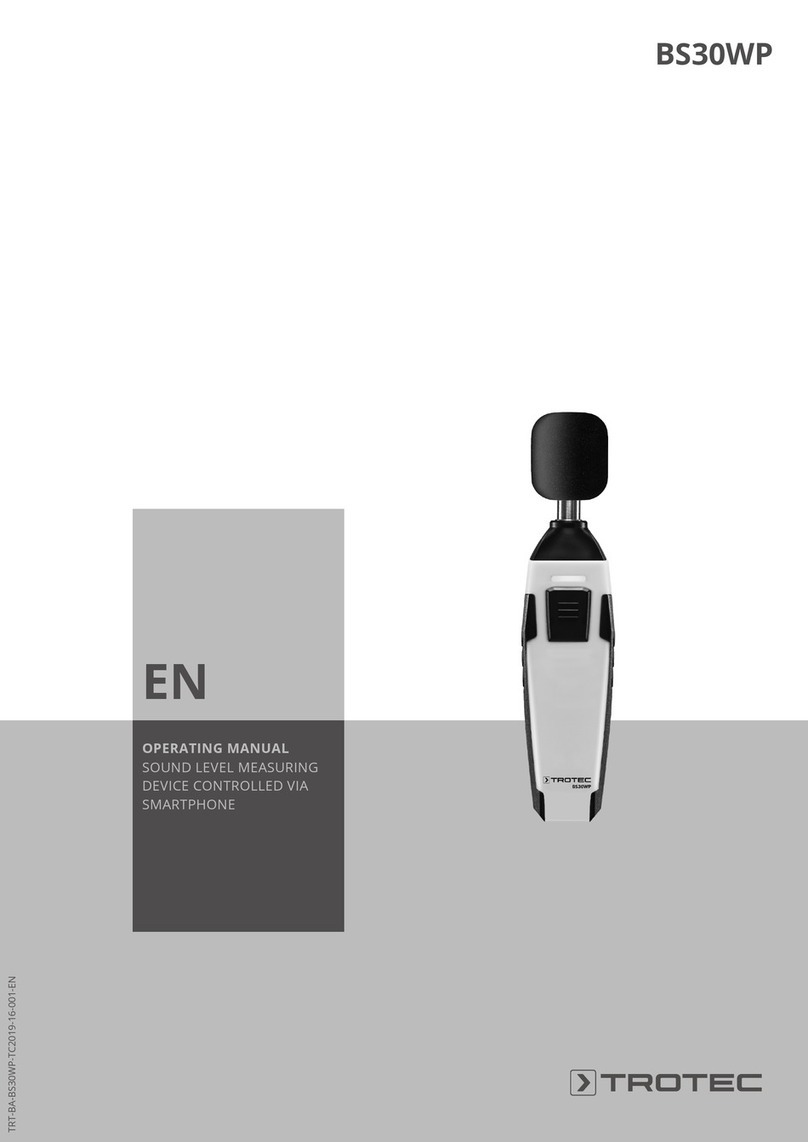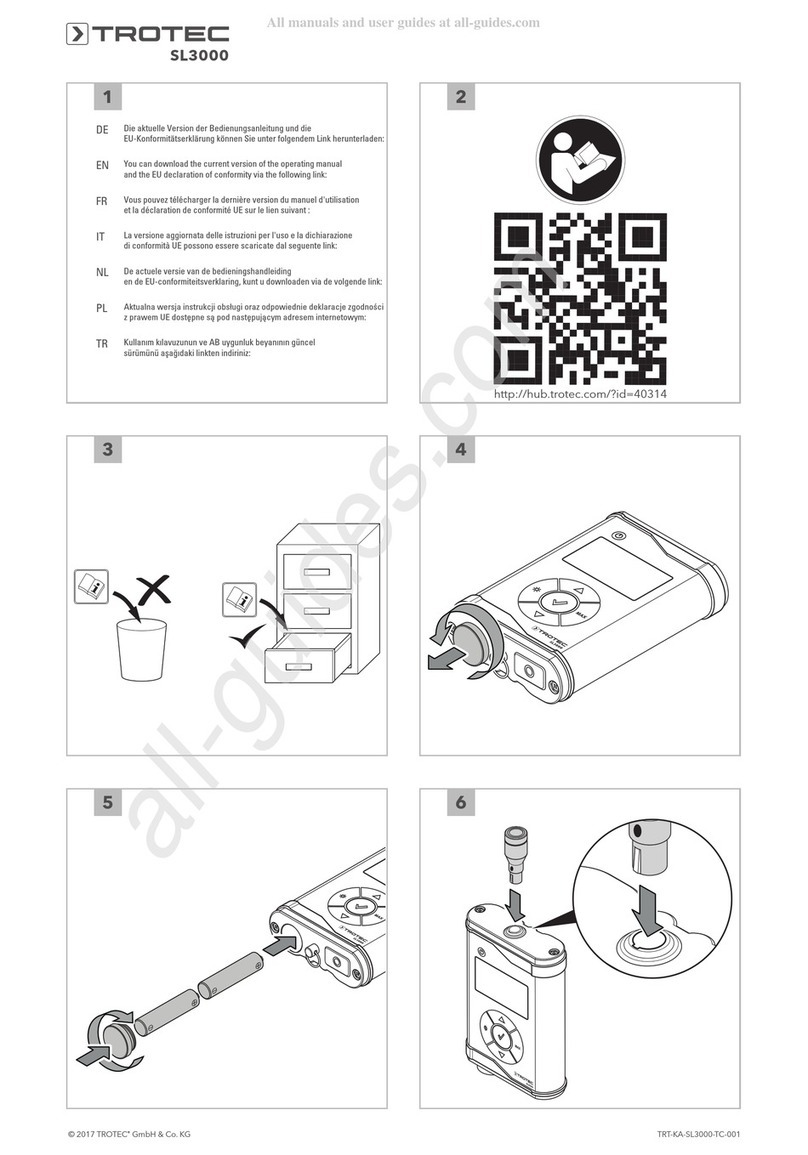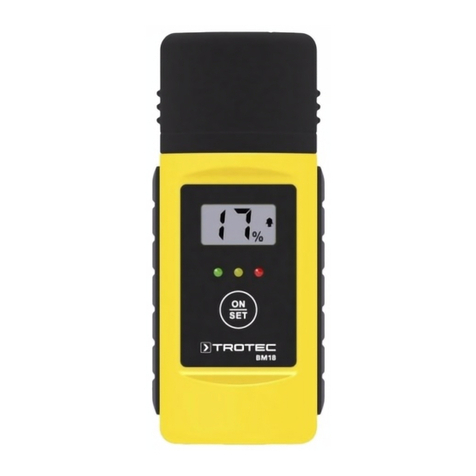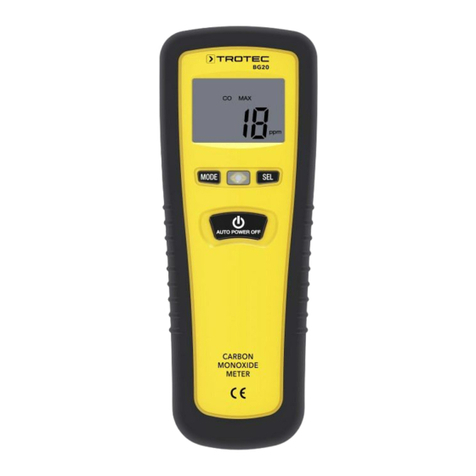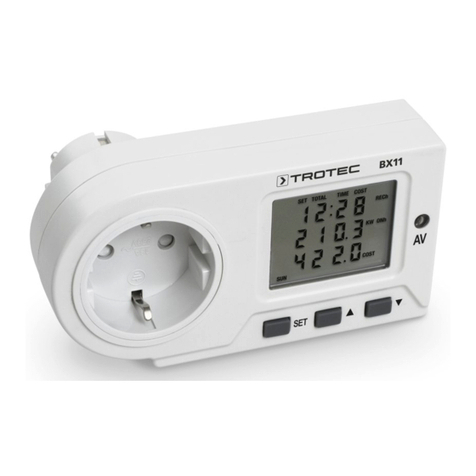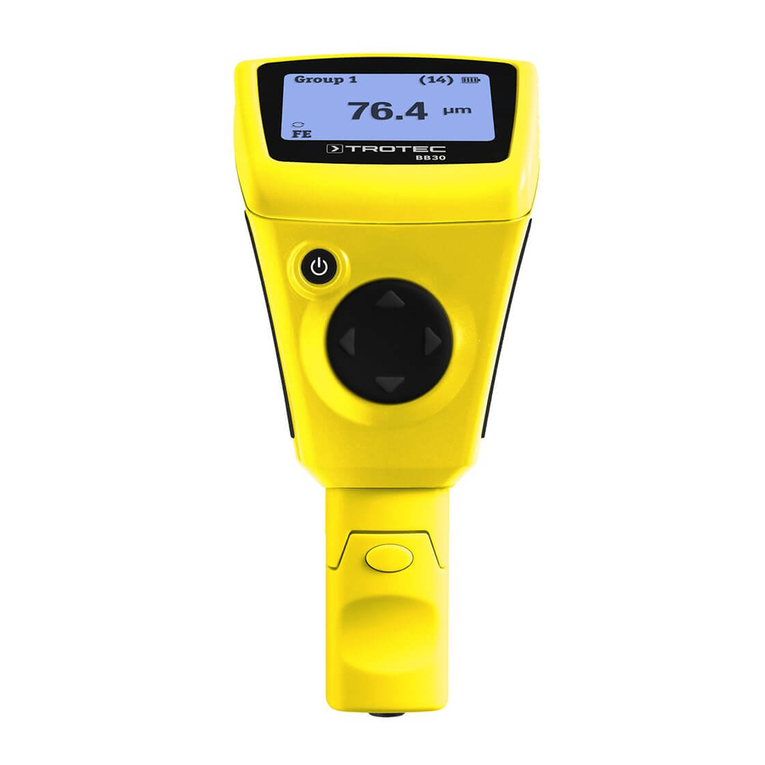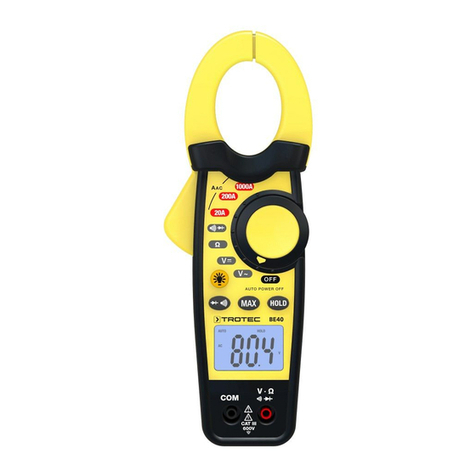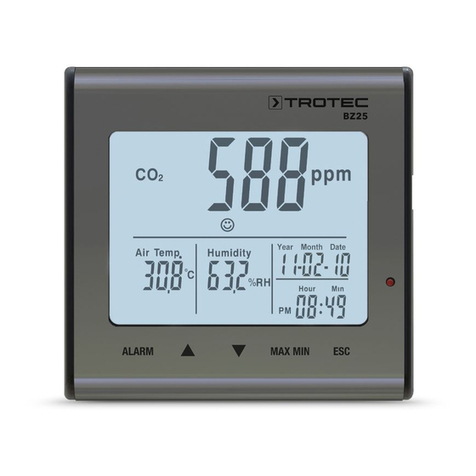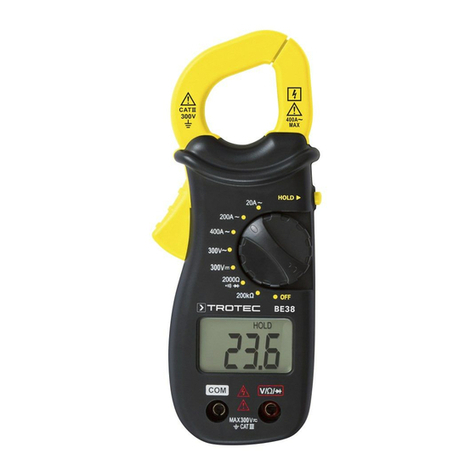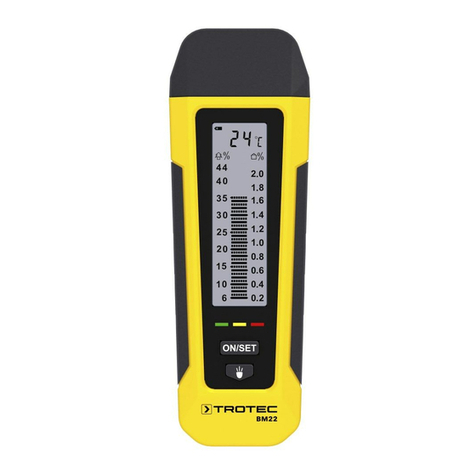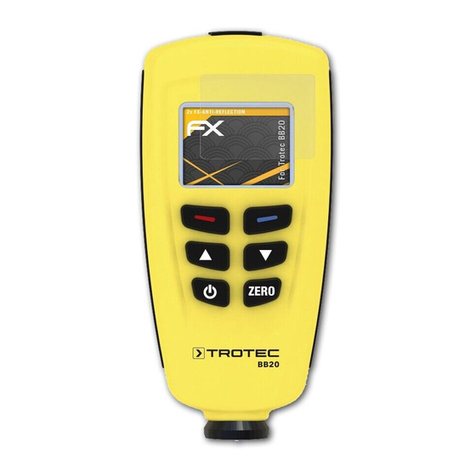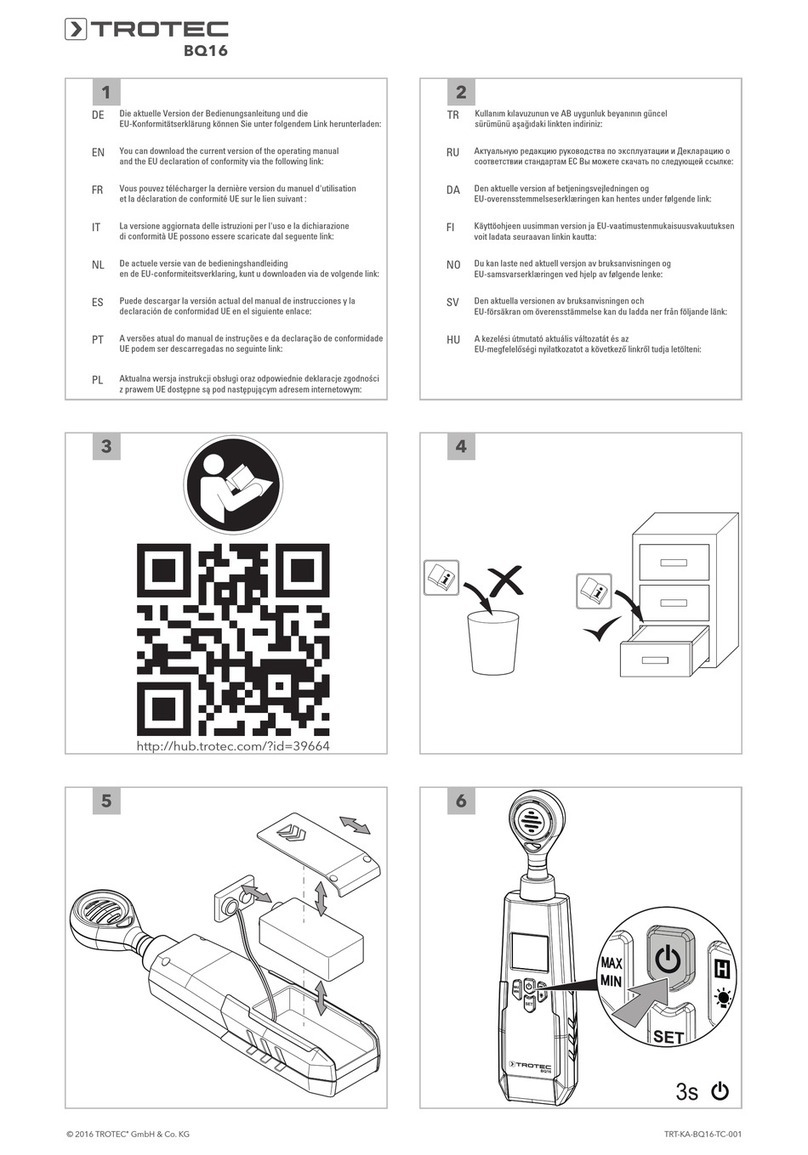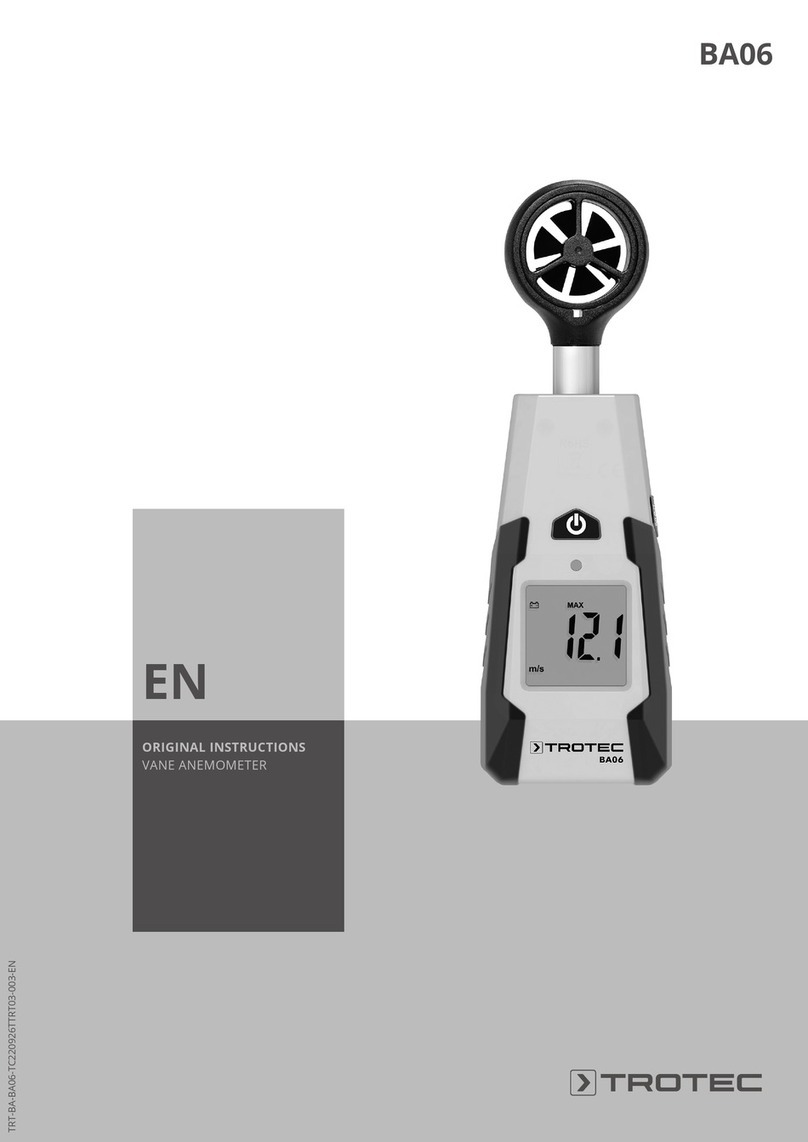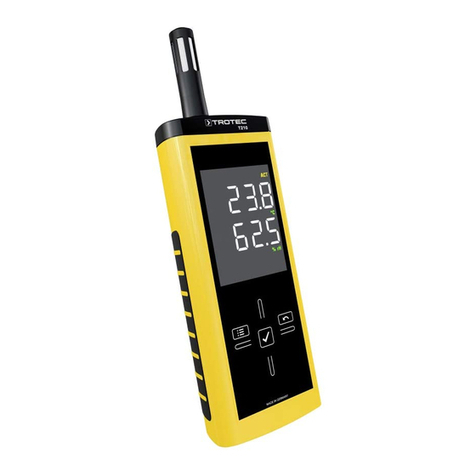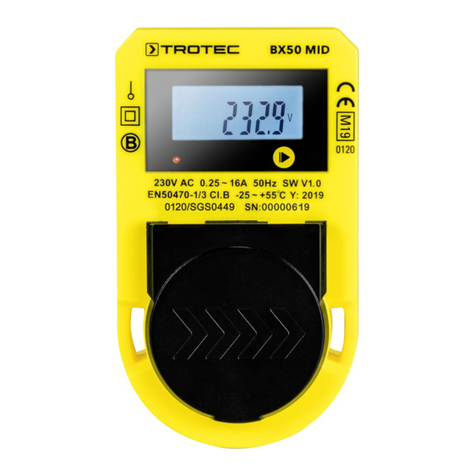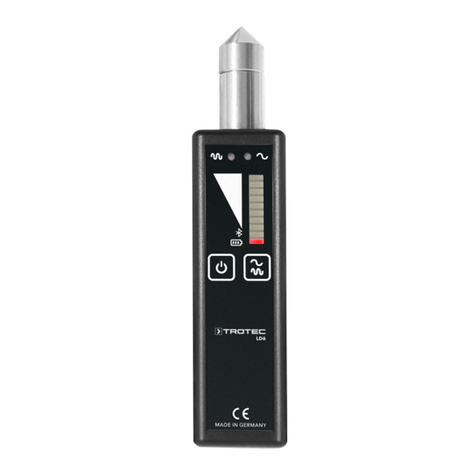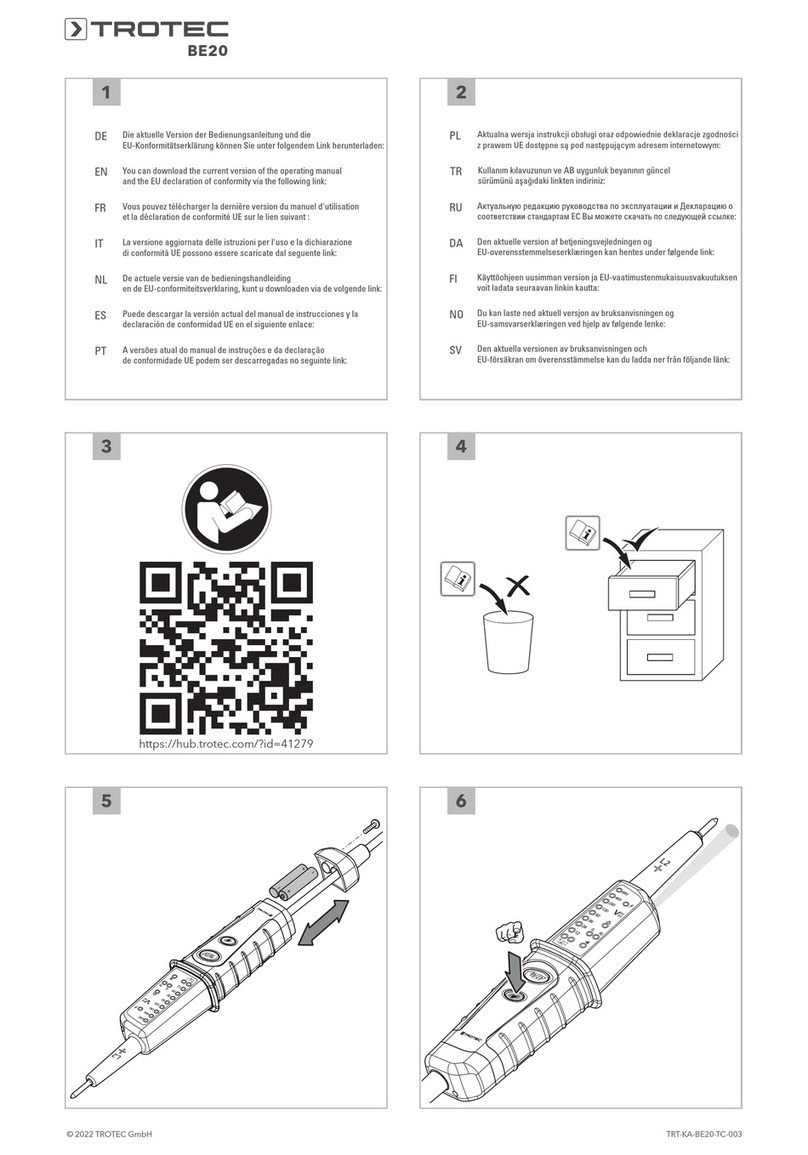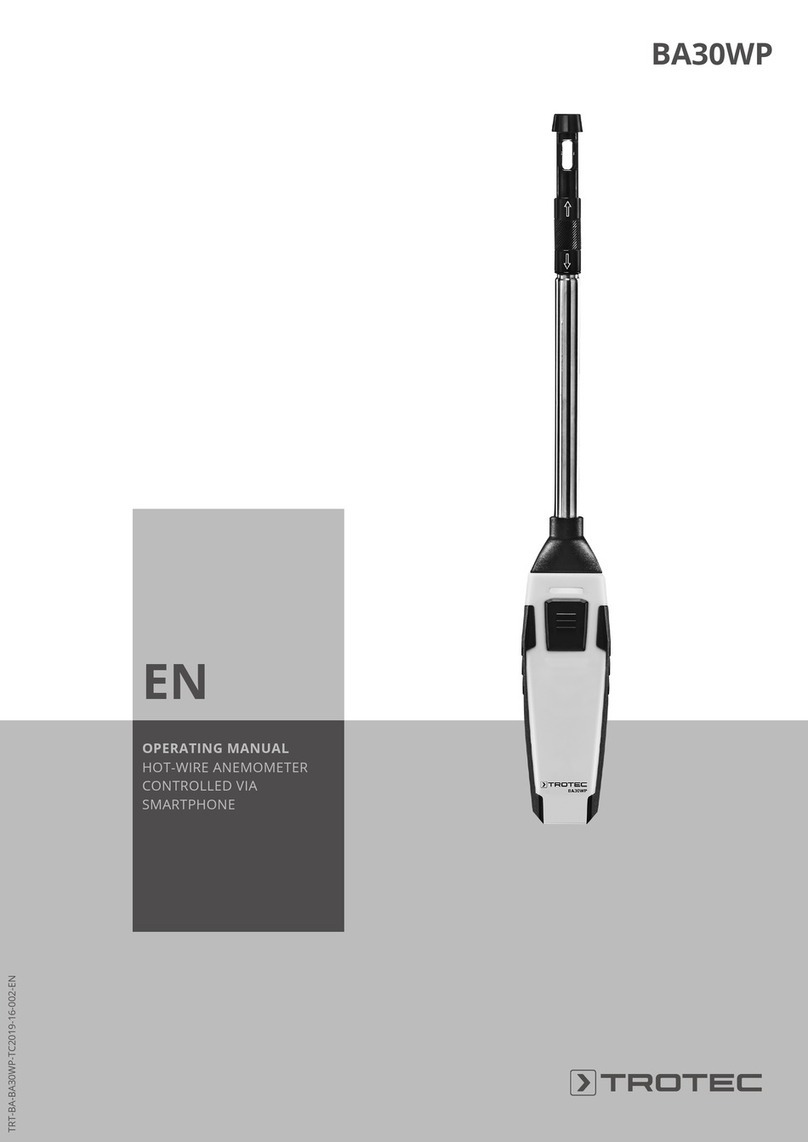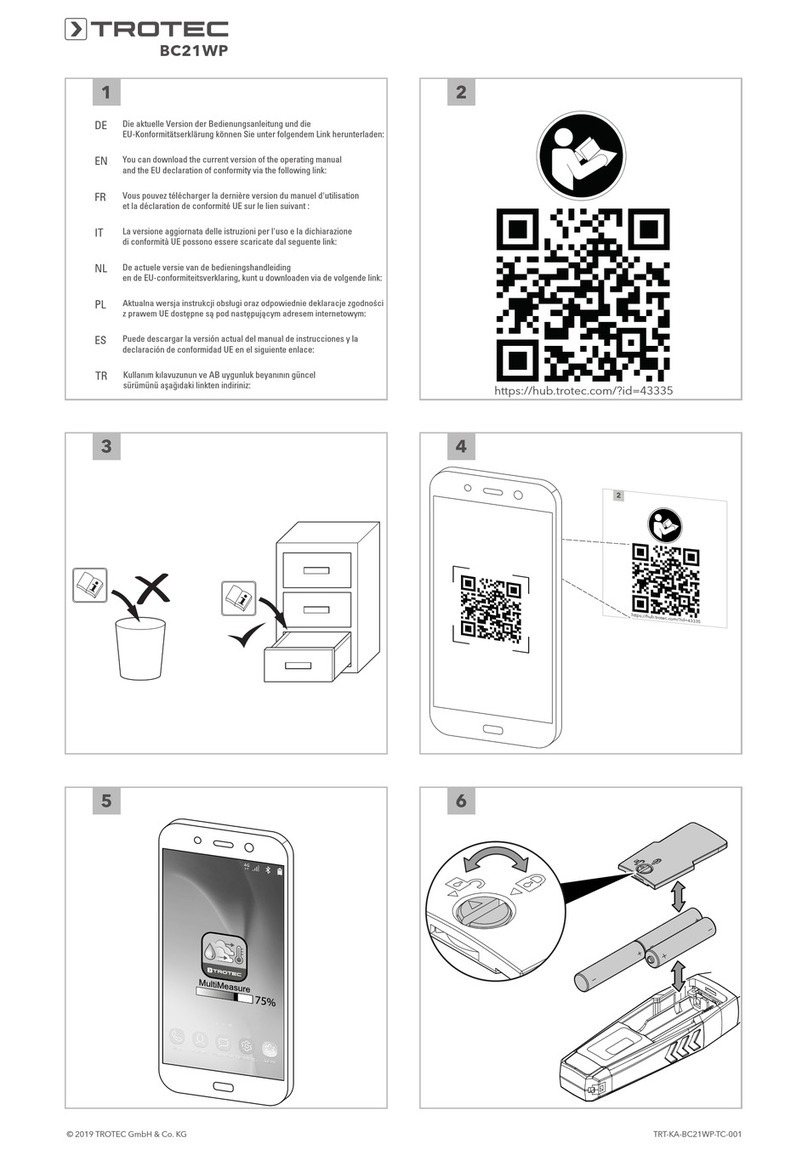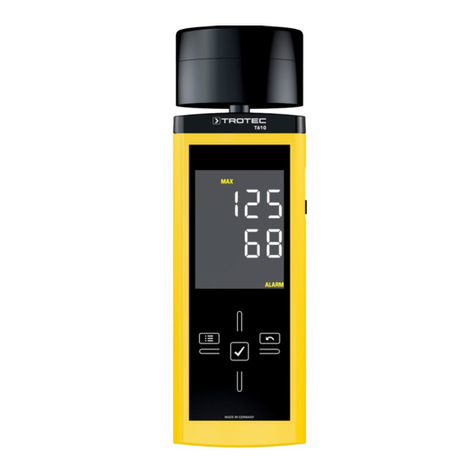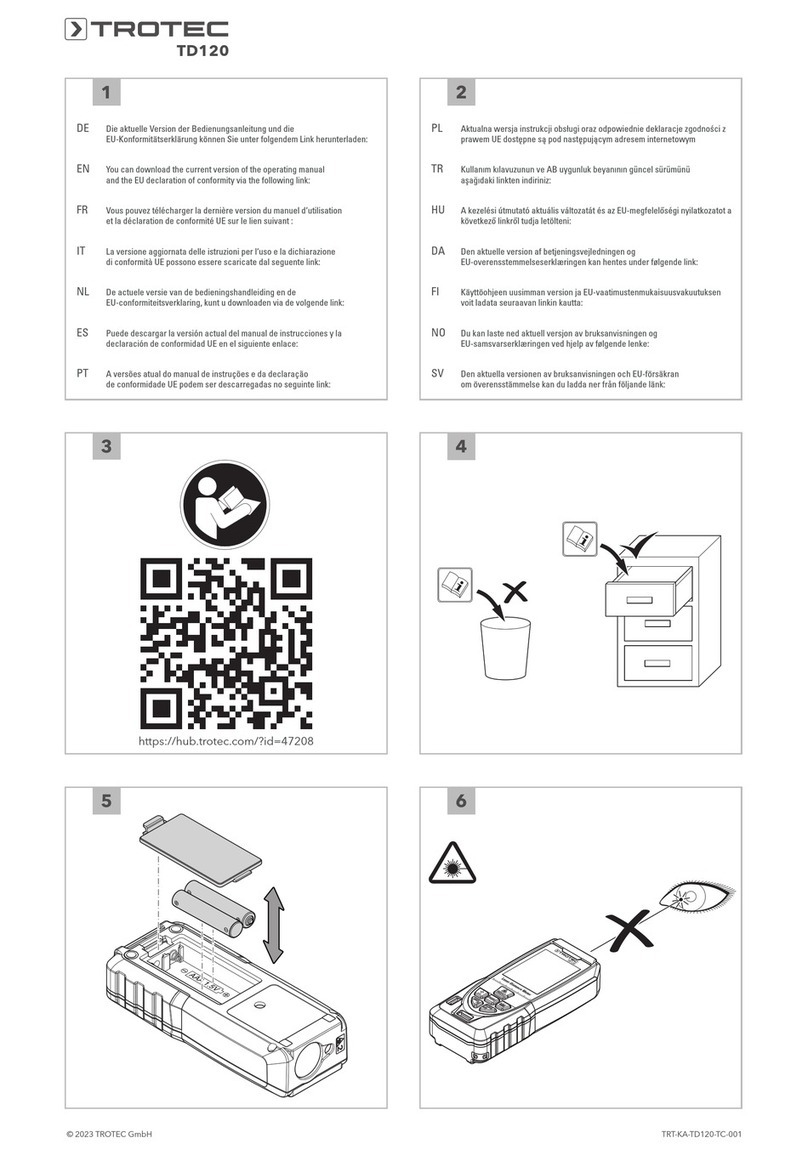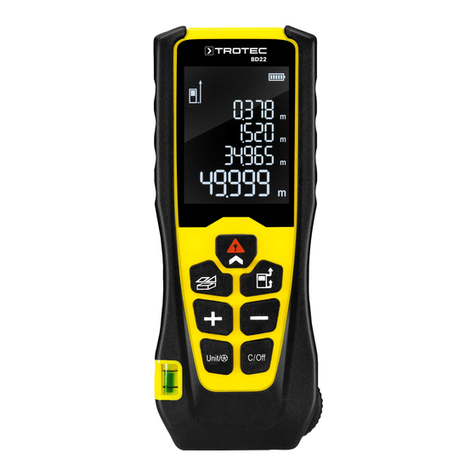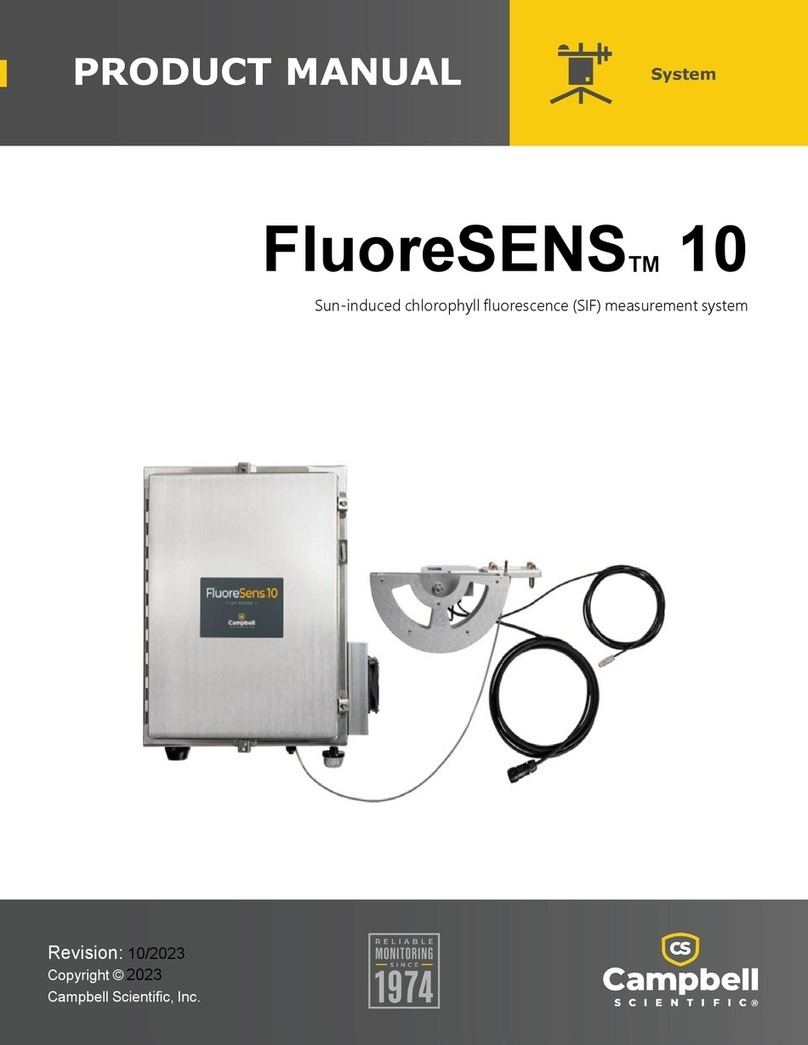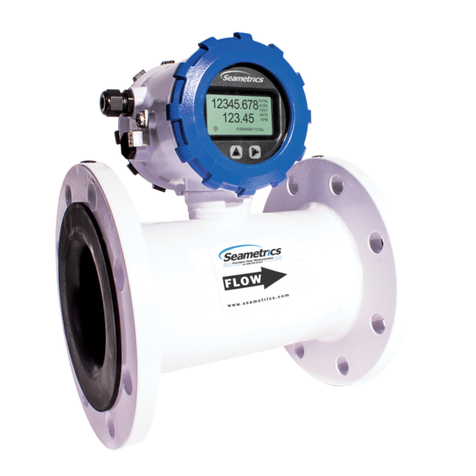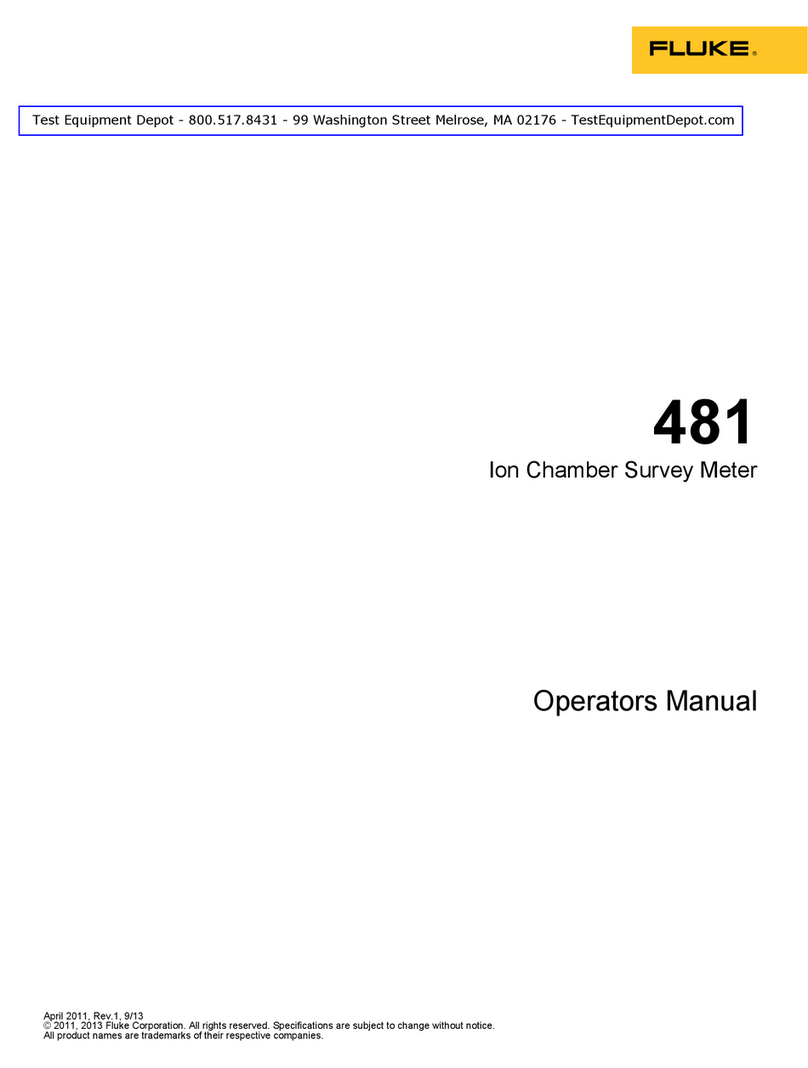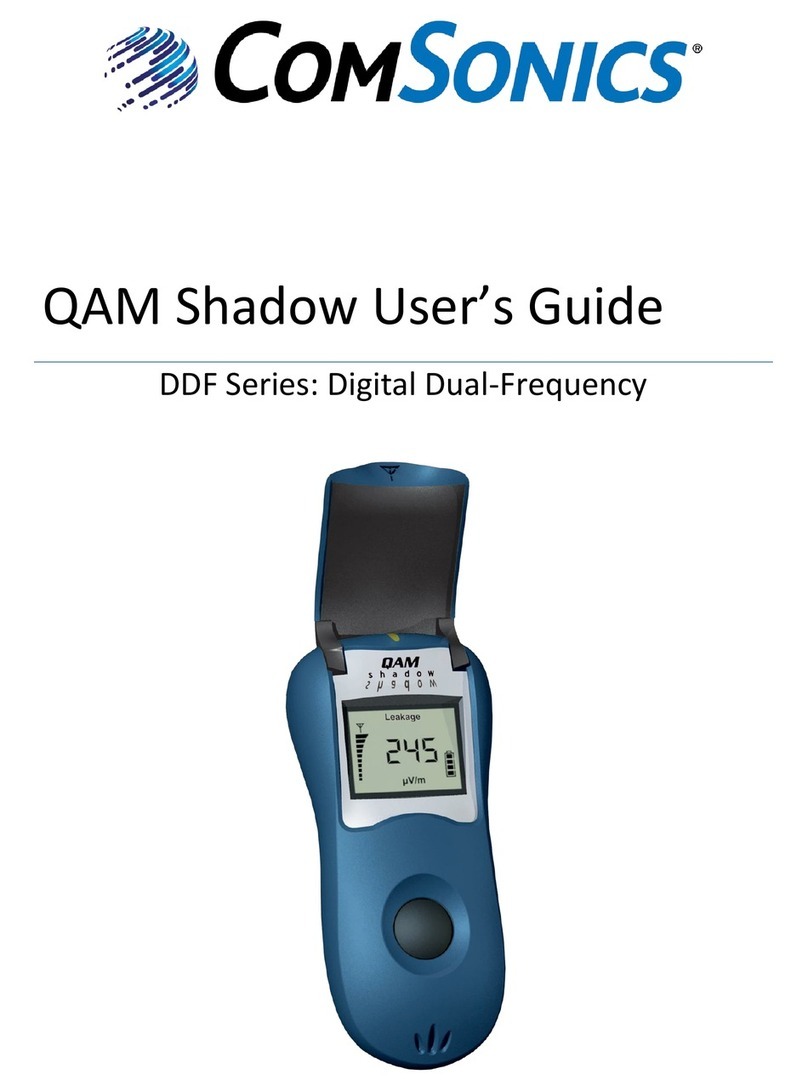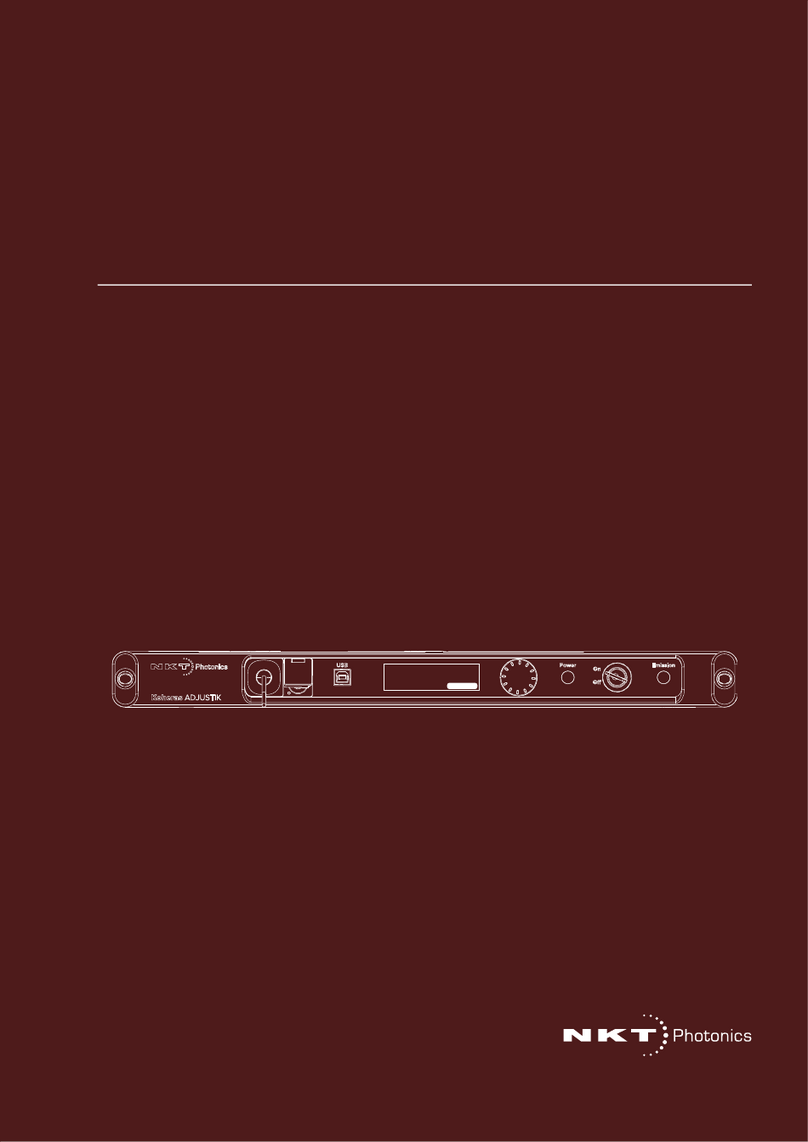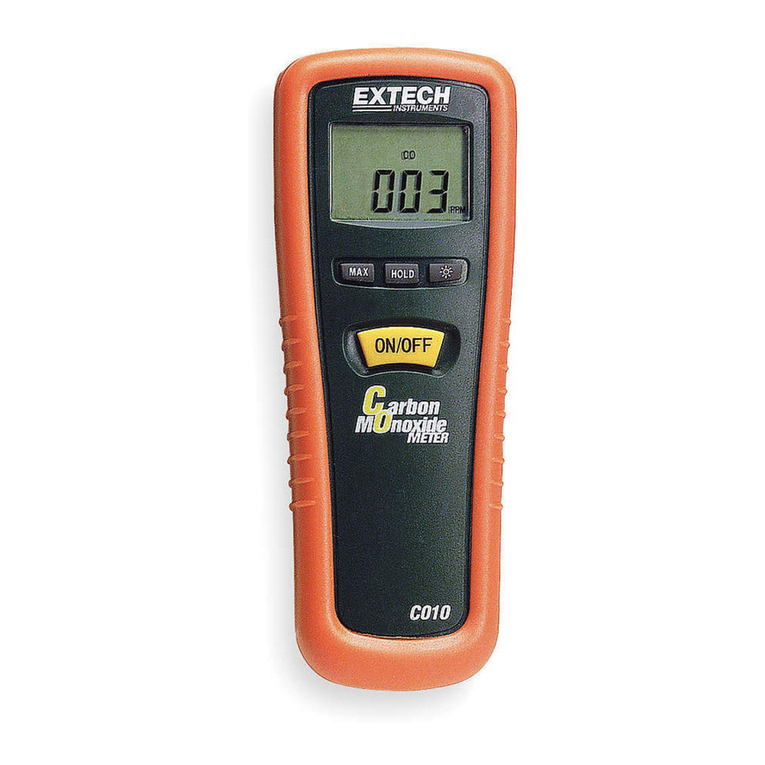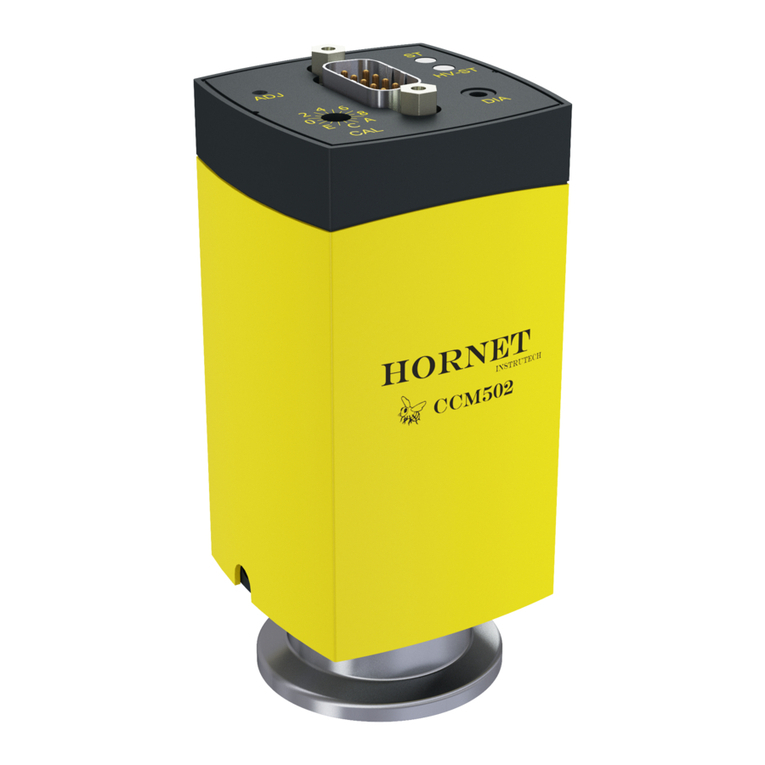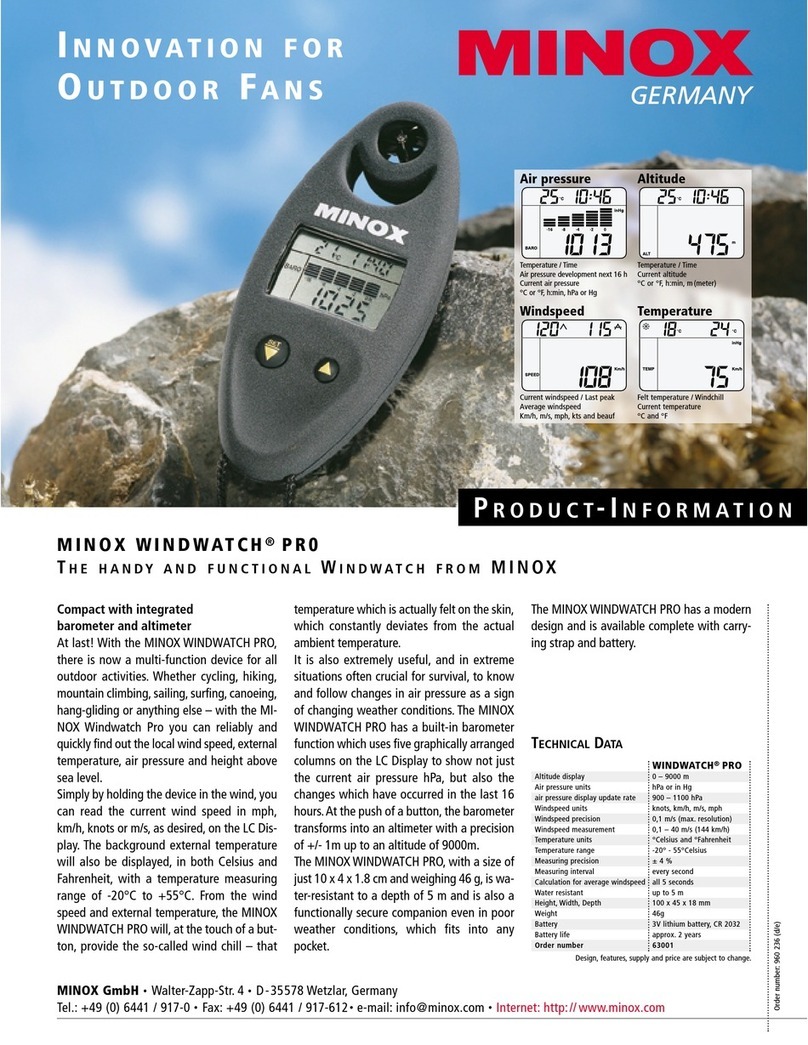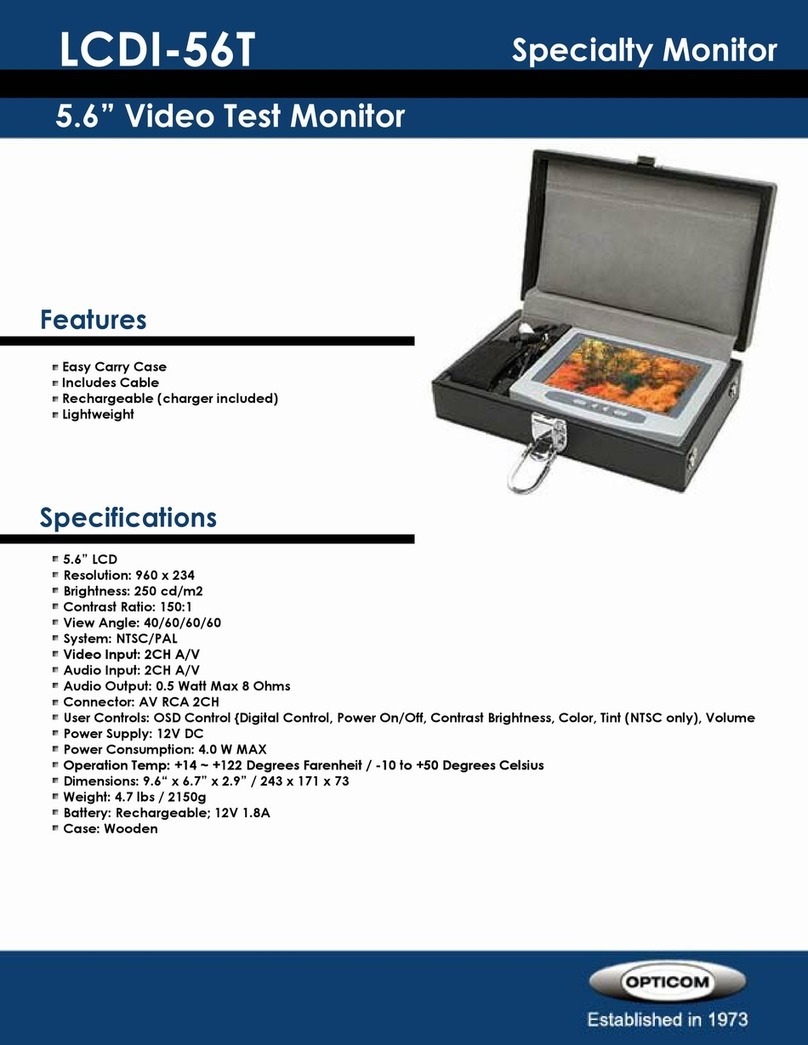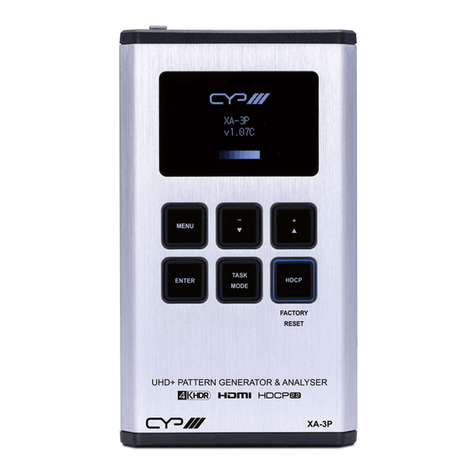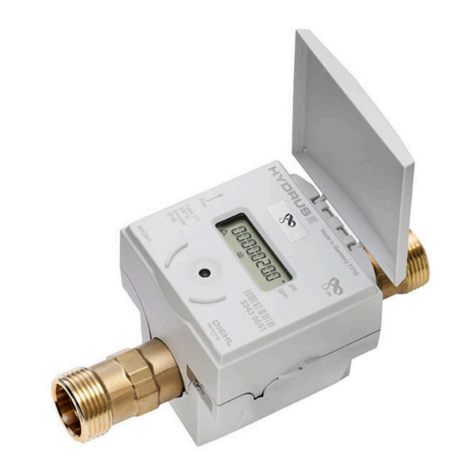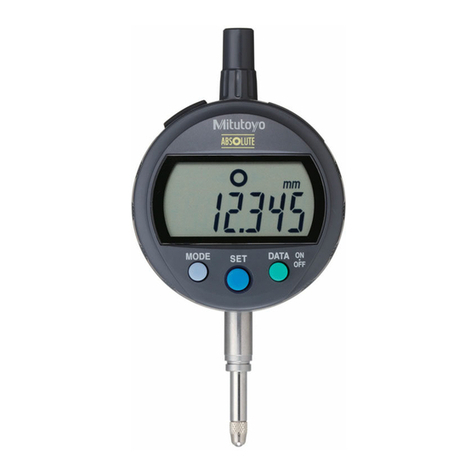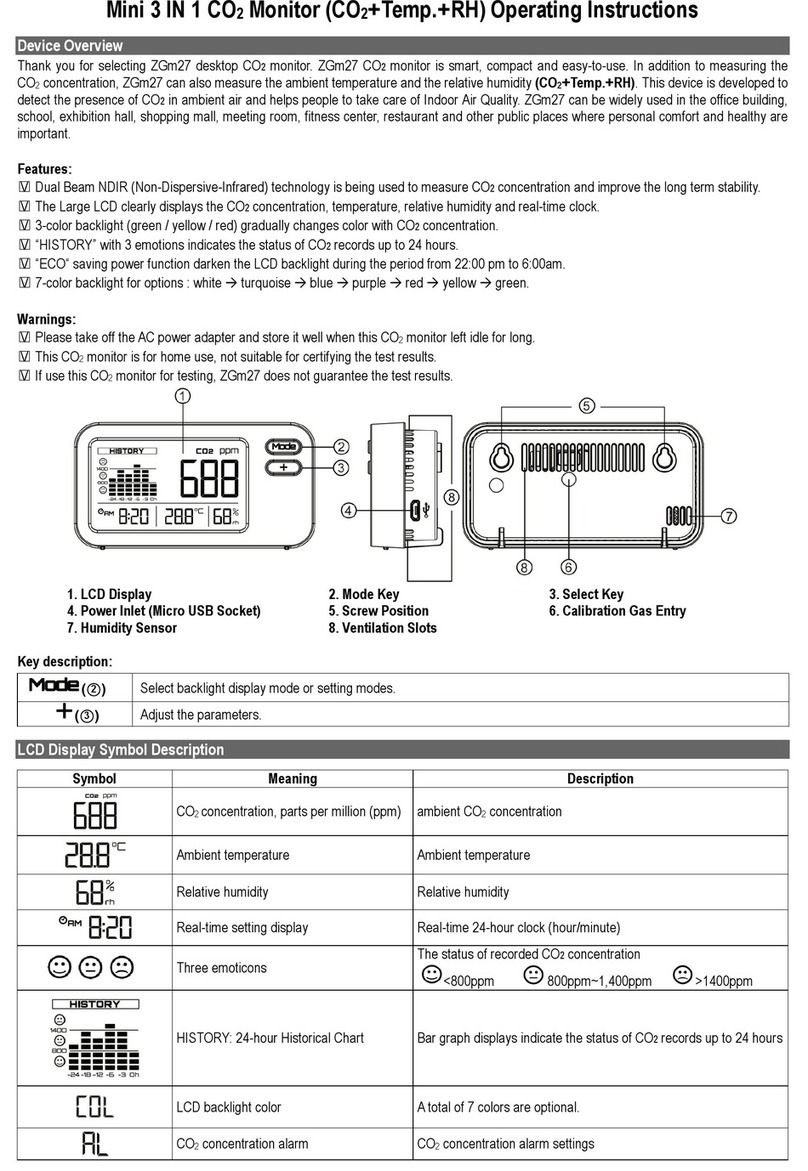Trotec LD20HC User manual

TRT-BA-LD20HC-TC211111TTRT02-002-EN
LD20HC
EN
ORIGINAL INSTRUCTIONS
CORRELATOR

2 EN
correlator LD20HC
Table of contents
Notes regarding the instructions .........................................2
Safety .....................................................................................2
Information about the device................................................4
Transport and storage...........................................................8
Start-up..................................................................................8
Operation .............................................................................11
Correlation ...........................................................................21
Acoustic leak detection.......................................................26
Practical information...........................................................31
Errors and faults..................................................................33
Maintenance and repair ......................................................35
Disposal ...............................................................................36
Declaration of conformity ...................................................36
Notes regarding the instructions
Symbols
Warning of electrical voltage
This symbol indicates dangers to the life and health of
persons due to electrical voltage.
Warning
This signal word indicates a hazard with an average
risk level which, if not avoided, can result in serious
injury or death.
Caution
This signal word indicates a hazard with a low risk
level which, if not avoided, can result in minor or
moderate injury.
Note
This signal word indicates important information (e.g.
material damage), but does not indicate hazards.
Info
Information marked with this symbol helps you to carry
out your tasks quickly and safely.
Follow the manual
Information marked with this symbol indicates that the
instructions must be observed.
You can download the current version of the instructions and
the EUdeclaration of conformity via the following link:
LD20HC
https://hub.trotec.com/?id=40995
Safety
Read this manual carefully before starting or using the
device. Always store the manual in the immediate vicinity
of the device or its site of use.
Warning
Read all safety warnings and all instructions.
Failure to follow the warnings and instructions may
result in electric shock, fire and/or serious injury.
Save all warnings and instructions for future
reference.
• Do not use the device in potentially explosive rooms or
areas and do not install it there.
• Do not use the device in aggressive atmosphere.
• Do not immerse the device in water. Do not allow liquids to
penetrate into the device.
• The device may only be used in dry surroundings and must
not be used in the rain or at a relative humidity exceeding
the operating conditions.
• Protect the device from permanent direct sunlight.
• Do not remove any safety signs, stickers or labels from the
device. Keep all safety signs, stickers and labels in legible
condition.
• Do not open the device.
• Only use the device, if sufficient safety precautions were
taken at the surveyed location (e.g. when performing
measurements along public roads, on building sites etc.).
Otherwise do not use the device.
• Observe the storage and operating conditions (see
Technical data).
• Never insert non-rechargeable batteries into the charger. A
charger that is suitable for one type of battery pack may
create a risk of fire and explosion, when used with another
battery pack or non-rechargeable batteries.
• Do not expose the charger to rain or wet conditions. Water
entering an electrical appliance increases the risk of
electric shock.
• Keep the charger clean. Contamination entails a risk of
electric shock.

EN 3
correlator LD20HC
• Check the charger, cable and plug before each use. Do not
use the charger if you detect any damages to the device.
Do not open the charger and have it repaired only by
qualified personnel and only with original spare parts.
Damaged chargers, cables and plugs increase the risk of
electric shock.
• Do not operate the charger on highly combustible ground
(e.g. textiles, paper etc.) or in an inflammable environment.
The heat generated by the charger during charging entails
a risk of fire.
• In case of damage and improper use of batteries, vapours
may be emitted. Provide for fresh air and seek medical
help in case of complaints. The vapours can irritate the
respiratory system.
• Under abusive conditions, liquid may be ejected from a
battery. Avoid contact with liquid ejected from the battery
as it may cause skin irritation or burns. If contact
accidentally occurs, flush with water. Seek medical help if
this liquid contacts eyes.
Intended use
The device LD20HC is a combined detector for electro-acoustic
leak detection using correlation, for electro-acoustic listening to
surfaces/ fittings and for acoustic pipe location. The device may
only be used for the given intended use while complying with
the specified technical data.
To use the device for its intended use, only use accessories and
spare parts which have been approved by Trotec.
Foreseeable misuse
Do not use the device in potentially explosive atmospheres or at
live parts. Trotec accepts no liability for damages resulting from
improper use. In such a case, any warranty claims will be
voided. Any unauthorised modifications, alterations or structural
changes to the device are forbidden.
Personnel qualifications
Only trained or instructed personnel who know and understand
the operating instructions and the possible dangers may work
with the device.
Personnel to be trained, instructed or undergoing training may
only work on the equipment under the constant supervision of
an experienced person.
People who use this device must:
• have read and understood the instructions, especially the
Safety chapter.
Residual risks
Warning of electrical voltage
There is a risk of a short-circuit due to liquids
penetrating the housing!
Do not immerse the device and the accessories in
water. Make sure that no water or other liquids can
enter the housing.
Warning of electrical voltage
Work on the electrical components must only be
carried out by an authorised specialist company!
Warning of explosive substances
Do not expose the batteries to temperatures above
60°C! Do not let the batteries come into contact with
water or fire! Avoid direct sunlight and moisture. There
is a risk of explosion!
Warning
Risk of suffocation!
Do not leave the packaging lying around. Children may
use it as a dangerous toy.
Warning
The device is not a toy and does not belong in the
hands of children.
Warning
Dangers can occur at the device when it is used by
untrained people in an unprofessional or improper way!
Observe the personnel qualifications!
Caution
Keep a sufficient distance from heat sources.
Note
To prevent damages to the device, do not expose it to
extreme temperatures, extreme humidity or moisture.
Note
Do not use abrasive cleaners or solvents to clean the
device.

4 EN
correlator LD20HC
Information about the device
Device description
The combination device LD20HC enables pinpoint leak detection
in pressurized pipeline systems. It can be used for both
performing correlations and for direct electro-acoustic listening.
The device is suited for leak detection in pipelines and drinking
water systems where a leakage noise is produced at the leak
point due to pressure. This noise travels through the pipeline in
both directions with parameters (volume, frequency) varying in
intensity and is detected by highly sensitive sensors installed at
accessible locations such as hydrants, valves etc.
Moreover, the device is able to detect leaks in pipes with up to
20different pipe materials and diameters in one measurement
(correlation). The amplified sensor signal is transmitted to the
central unit by radio. The device allows to amplify the signal
received more than 60,000 times using the geophone. It
contains 256freely selectable filters to be used for the signal
received.
Device depiction
1
2
3
4
5
6
7
8910
11
No. Designation
1 Shoulder strap
2 Rotary button
3 Touchscreen
4 Control panel
5 Port with cover for PC connection cable
6 Headphone connection with cover
7 Left antenna connection
8 Right antenna connection
9 Microphone connection
10 Charging socket
11 LEDs battery status

EN 5
correlator LD20HC
Central unit control panel
12
13
14
2
3
No. Designation
2 Rotary button
3 Touchscreen
12 Power button
13 Cancel button
14 Record button
Transmitter device depiction
16
18
15
20
17
19
No. Designation
15 Displays
16 Jack socket for headphones
17 Connection for structure-borne sound receiver
18 Shoulder strap
19 Charging connection
20 Transmitter antenna connection
Transmitter control panel
15
15c
15b
15a
No. Designation
15 Displays
15 a Arrow button up
15b Arrow button down
15c Confirm or On/Offbutton

6 EN
correlator LD20HC
Accessories
21 22 23
24
27
25
No. Designation
21 Central unit antenna (2x)
22 Transmitter antenna (2x)
23 Headphones
24 Charger with distributor and connection cables
25 Reset dongle
27 Structure-borne sound receiver
Optional accessories
Microphones and sensors
28
29
32
31
30
No. Designation
28 Probe rod upper part
29 Tripod magnet
30 Probe rod extensions
31 Probe rod lower part
32 Ground microphone

EN 7
correlator LD20HC
Technical data
Parameter Value
Receiver
Operating modes Leak detection via correlation
(automatic, manual)
acoustic leak detection (volume,
smart)
Measuring and device
functions
automatic filter adjustment,
automatic amplification, preference
memory function for manual filter
settings, sound level override
protection
Measurement resolution
correlation
5 cm for a measuring distance of
100 m
Measurement resolution
geophone
0–99digits (equivalent to dB)
Control optionally via touchscreen or buttons
and control dial
Amplification 120dB with low noise figure
Input impedance 1 MΩ
Filter 256 high-pass and low-pass filters
Display 5.7" touch colour LCD with
background illumination
battery check via micro controller
Output impedance < 10 Ω
Power supply integrated NiMH battery, 8500 mAh
Operating time approx. 10h in continuous operation
with fully charged battery
Memory up to 100 measurements per
operating mode
Connections 2x SMA antenna sockets
bayonet sensor connection
4-pin charging socket with cover
3-pin headphone connection with
cover
USB cable connection with cover
Type of protection IP65
Housing aluminium, powder-coated
Temperature conditions Operation: -20 °C to +60 °C
Storage: -25 °C to +65 °C
Dimensions
(lengthx widthx height)
approx. 380 x 155 x 67mm
Weight approx. 2,300g
Parameter Value
Transmitter
Display numeric and graphic sound level
Amplifier stages The device comes with 3amplifier
stages:
• No.1: pre-preamplifier
• No.2: preamplifier
• No.3: post-amplifier
Filter function The device comes with 5filter
functions:
• open= 0–5000Hz
• low= 0–300Hz
• medium= 200–800Hz
• high= 600–1400Hz
• very high= 1000–4000Hz
Amplification Automatic pre- and post-
amplification, -10 to +10 steps
manually adjustable for pre-
amplification
5preset filter ranges
Transmission power 500mW maximum
Frequency bands ChannelA: 433.7MHz
ChannelB: 434.7MHz
ChannelC: 434.0MHz
Background illumination Automatic
Temperature conditions Operation: -20 °C to +60 °C
Storage: -25 °C to +65 °C
Power supply integrated NiMH battery
Dimensions
(lengthx widthx height)
approx. 175 x 165 x 155mm
Structure-borne sound sensors
Sound receiver Piezoceramic
Connections TNC antenna connection
bayonet sensor connection
4-pin charging socket with cover
3-pin headphone connection with
cover
Type of protection IP68
Housing aluminium, powder-coated
Operating time approx. 7h in continuous operation
with fully charged battery
Weight approx. 2,900g

8 EN
correlator LD20HC
Scope of delivery
• 1 x Central unit with two antennas and a shoulder strap
• 1 x Transmitter 1 incl. sound receiver, coloured yellow
• 1 x Transmitter 2 incl. sound receiver, coloured red
• 1 x Headphones with sound protection
• 1 x Charger
• 1 x Reset dongle
• 1 x Transport case
• 1x Manual
Transport and storage
Note
If you store or transport the device improperly, the
device may be damaged.
Note the information regarding transport and storage of
the device.
Transport
For transporting the device, use the transport case included in
the scope of delivery in order to protect the device from external
influences.
Storage
When the device is not being used, observe the following
storage conditions:
• dry and protected from frost and heat
• protected from dust and direct sunlight
• the storage temperature complies with the values specified
in the Technical data
Start-up
Charging the battery of the central unit
Before use make sure that the battery of the central unit is
charged.
A full charging cycle (completely empty until completely
charged) takes approx. 8–10h.
Please note the LEDs(11) on the right-hand side of the central
unit. They indicate the following:
Blue LED illuminated = battery charging
Green LED illuminated = battery fully charged
Orange LED illuminated = power adapter connected and
supplied with voltage
1. Remove the cover from the charging socket(10) of the
central unit.
10
2. Insert the mains plug of the charger(24) into a properly
fused mains socket.
3. Plug the charging cable into the charging socket(10) of the
central unit. Make sure that the red marks on the charging
socket and on the charging cable connector are aligned.
11
24
ðThe orange and blue LEDs(11) light up.

EN 9
correlator LD20HC
4. Wait until the battery is fully charged.
ðThe green LED(11) lights up.
5. Remove the cable from the charging socket and reattach
the cover to the charging socket.
Charging the battery of the transmitter
Before use make sure that the battery of the transmitter is
charged.
A full charging cycle (completely empty until completely
charged) takes approx. 5–6h.
The left and right displays(15) show the following information
during the charging process:
• The left display shows the battery status with a flashing
battery level indication(15p).
• The right display shows the percentage of the battery
status(15o).
15o
15p
The battery is fully charged when the battery status(15o) shows
100% and the battery level indication(15p) stops flashing.
1. Insert the mains plug of the charger(24) into a properly
fused mains socket.
2. Plug the charging cable into the charging socket(19) of the
transmitter. Make sure that the red marks at the charging
socket and at the charging cable connector are aligned.
19
3. Wait until the battery is fully charged.
4. Remove the cable from the charging socket and reattach
the cover to the charging socket.
Connecting the antennas to the central unit and
transmitters
Info
If the antenna is not connected, the radio module may
overheat and get damaged.
Risk of overheating of the radio module
To enable communication between the transmitters and the
central unit, the antennas must be connected.
1. Screw the two antennas of the central unit(21) to the
left(7) and right(8) antenna connection of the central unit.
21
21
7
8
2. Orient the two antennas(21) towards the top.

10 EN
correlator LD20HC
3. Connect the antennas for the transmitters(22) to the
antenna connection(20) of the red and yellow transmitter.
20
22
Connecting the headphones
The headphones can be connected to the central unit if
required.
Only use the original headphones for your measurements. The
headphones are used to listen to the noise transmitted by
transmitters A/B/C, ground microphone or other sensors and to
make filter and amplification settings on that basis.
1. Remove the cover from the headphone connection(6).
2. Connect the headphones(23) to the headphone
connection(6) of the central unit. Make sure that the red
marks on the headphone connection and on the device
connector are aligned.
23 6
Connecting the transmitters
Info
If, after the sensors have been installed and the
transmitters switched on, no noise can be heard and
the display on the transmitter indicates a value near 0,
reduce the distance from the leak or select another
sensor type.
The transmitters can be positioned at a distance of up to
1500m from the central unit. Please note the following
information for positioning the transmitters:
• The maximum distance of up to1500m applies for a free
area. Obstacles such as houses or trees may affect the
transmission capacity. The distance must be reduced in
this case.
• The minimum distance from the central unit is
approx.10m. In this context, please note that
measurements performed in indoor areas such as blocks
of flats are prone to error due to a considerable amount of
interfering noise.
• The pipe section to be measured should be as straight as
possible and have as few pipe bends as possible to
guarantee an accurate measurement with preferably little
interfering noise.
1. Connect the required sensor to the connection(17) of the
corresponding transmitter (example: structure-borne
sound receiver(27)).
17
27
2. Position the transmitters with the sensor on the leaking
pipeline.
3. Press the Power button(12) to switch the transmitters on.
ðThe current level is displayed as a bar.
ðAmplification takes place automatically.
4. Make any further settings at the central unit if necessary.
Info
If, after the sensors have been installed and the
transmitters switched on, no noise can be heard and
the display on the transmitter indicates a value near 0,
reduce the distance from the leak or select another
sensor type.

EN 11
correlator LD20HC
Operation
Central unit main menu
40
41
42
43
44
45
No. Designation
40 Battery indication
41 Acoustic leak detection(geophone measurement)
42 Data exchange with a PC
43 Settings
44 Correlation measurement
45 Date and time indication
Transmitter main menu
15e15f15g15h15i15j
15m
15d
15n15l15k
No. Designation
15d Retuning indication
15e Numerical value for pre-/post-amplifier (optional)
15f Battery status
15g Graphic noise level bar
15h Low-pass filter indication
15i High-pass filter indication
15j Frequency response line
15k Main frequency of the present noise (highest
amplitude)
15 l Numeric noise level
15m Filter menu
15n Amplifier menu for preamplifier (A=automatic /
M=manual)
Automatic adjustment of the transmitter
Info
The sound receiver must be placed on the pipeline
before switching on.
After switching on the transmitter, the amplification is adjusted
automatically. The amplification is selected on the basis of the
available useful signal. The automatic amplification usually also
corresponds to the optimal measurement setting. If the
automatic amplification is too strong or too weak, the
amplification must be changed manually.

12 EN
correlator LD20HC
Manual adjustment of the transmitter
Info
If the automatic amplification does not correspond to
the optimum, it can be adjusted manually. To assess
whether the useful signal (leak noise) is correctly
amplified, listen to the signal via the headphones
directly at the measurement box. The sound should be
clearly audible, but not overdriven or "tinny". Another
indication of an incorrect amplification is the noise
level bar(15g). If it is constantly at full scale, the
amplification should be reduced. If the noise level bar
is permanently at a very low level, i.e. there is hardly
any deflection, the amplification should be increased.
In the standard version, the transmitters have two amplifier
stages:
1. Fixed amplifier on the receiver (pre-preamplifier)
2. Adjustable preamplifier (before filtering the signal)
The following equipment is reserved for the professional
version only: Optional amplifier stage no.3 (post-amplifier,
after filtering the signal).
To change the amplifier no.2 (preamplifier), please proceed as
follows:
1. Place the cursor on the amplifier menu(15n).
15n
15a
15b
15c
2. Press the confirmation button(15c).
3. Use the Up/Downarrow buttons(15a/15b) to set the
pre-amplification between -10 and +10.
There are a total of 18levels (1–18) for amplifier no.2. If, for
example, the automatic amplification has been set to numerical
value5, the maximum level that can be reached during manual
adjustment is 15[5+10]. In the other direction, only the lowest
amplification level[1] can be reached. The negative range
cannot be selected.
The following step is reserved for the professional version
only: To change the amplifier no.3 (optional post-amplifier),
please proceed as follows:
1. Place the cursor on the right field of the numerical value
pre/-post-amplifier(15e).
2. Press the confirmation button(15c).
3. Use the arrow buttons(15a/15b) to set the post-
amplification between 1 and 254.
4. The numerical value always starts at the value that has
been automatically determined beforehand. You can adjust
this value in steps of3.
ðTo prevent making accidental and incorrect settings,
manual settings are deleted as soon as another filter is
selected, the device is retuned or switched off/on.
Selecting the filter range of the transmitter
The transmitter has 5preset filter functions.
In the professional version, the two filters "high-pass" and
"low-pass" can also be changed in 50Hzsteps in order to
achieve an extremely fine tuning of the useful signal and to
eliminate noise as well as possible. This function can
significantly improve measurement results or even make a
measurement possible in the first place. However, using this
function requires experience and knowledge, without which
measurements may lead to no result (correlation) in extreme
cases!
The numerical values are indicated on the left display below the
frequency indication.
15h
15i
No. Designation
15h Low pass (frequencies above this numerical value are
clipped)
15i High pass (frequencies below this numerical value
are clipped)
This means that only frequencies within the two displayed
numerical values are sent to the central unit (correlator) via
radio.

EN 13
correlator LD20HC
Selection of the prefilter
Please proceed as follows to select the prefilter:
1. Use the Up/Down arrow buttons(15a/15b) to select the
prefilter menu(15m).
15m
15a
15b
15c
2. Press the Confirmbutton(15c) until you have selected the
desired symbol (see filter area symbols).
Symbol Filter
range no.
Name and filter range(Hz)
1 Entire frequency range, (0– 5000Hz)
no filter active
2 Low frequency range,
(approx.0– 300Hz)
3 Medium frequency range
(200– 800Hz)
4 High frequency range
(600– 1,400Hz)
5 Very high frequency range
(1,000– 4,000Hz)
Freely selectable filter range
The following step is reserved for the professional version
only!
1. To manually limit a frequency range, move the cursor to
one of the numerical values (15i/15h) on the left display.
2. Select the preset frequency range1 for the maximum
possible selection.
3. If a different resolution is desired, it is also possible to filter
in one of the 4other preset frequency ranges.
4. The filter levels can be adjusted for both the high pass
(only frequencies above this numerical value are
considered) and the low pass (only frequencies below this
numerical value are considered) in steps of 50Hz.
Retuning the transmitters
Info
If the transmitters are repositioned or the leak noise
changes during the measurement, the transmitters
should be retuned.
1. Press the Power button(15c) to switch the device off.
2. Press the Power button(15c) to switch the device back on.
You can also perform retuning via the menu item. To do so,
please proceed as follows:
1. Use the Up/Down arrow buttons(15a/15b) to select the
Retuning(15d) indication.
2. Press the Confirmation button(15c) to confirm.
ðThe amplifier is readjusted and the noise level is
recalculated.
Switching the central unit on
Please proceed as follows to switch on the central unit:
1. Press the Power button(12) at the central unit.
ðThe central unit starts up.
ðThe start screen is displayed.

14 EN
correlator LD20HC
Control and menu structure
Control
After switching the central unit on, the main menu opens. Here
you have the following options:
The central unit comprises menu and selection fields, which can
be selected either directly via the touchscreen(4) or using the
rotary button(2).
• When using the touchscreen, simply press on the desired
menu or selection field with your finger.
• Alternatively, you can turn the rotary button to the right or
left to navigate through all menu and setting fields
available. Active menu items or selection fields are
highlighted in yellow with a red frame.
– To confirm your selection, press the rotary button(2).
The desired menu or selection window is now
displayed.
• By pressing the Cancel button(13) you can exit the current
menu or selection window.
To return to the main menu from any submenu, press the Exit
menu symbol(53, door symbol) or the red X (Cancel button, 13).
Central unit settings
The Settings menu can be opened by pressing the settings
symbol(43) in the main menu.
47 48 49
56
57
46
50
51
52
53
5455
58
55a
No. Designation
46 Ear protection
47 Language
48 Operating time
49 Touchscreen
50 Illumination
51 Factory settings
52 Device information
53 Exit menu
54 Units
55 Frequency settings/ correlation
55 a Trans Auto
56 Correlator inputs
57 Frequency range / geophones
58 Date and time
Navigate to the desired settings item and select it in order to
make the following configurations:

EN 15
correlator LD20HC
Date and time
In this submenu you can make settings regarding date and time.
1. Use the rotary button(2) to navigate to the Date and time
submenu(58).
ðThe selected settings field is highlighted in yellow with a
red frame.
2. Confirm your selection by pressing the rotary button.
ðThe Date and time submenu(58) will be displayed.
3. You can change the settings (1 to 31 for the day; 1 to 12
for the month; 10 to 99 for the year) by turning the rotary
button.
ðIf you want to enter the values directly via the
touchscreen, use the number field at the bottom.
4. You can confirm your entry by pressing OK and delete it by
pressing DEL.
5. To confirm the selection, press the rotary button again. To
abort the changes, press the Cancel button(13).
6. To confirm the newly set values and leave the menu, press
the door symbol. To discard all settings and leave the
settings menu, press the Cancel button(13).
Language
In this submenu you can set the display language.
1. Use the rotary button(2) to navigate to the Language
submenu(47).
ðThe selected settings field is highlighted in yellow with a
red frame.
2. Confirm your selection by pressing the rotary button.
ðThe Language submenu(47) will be displayed.
3. Navigate to the desired language.
ðThe selected settings field is highlighted in yellow with a
red frame.
4. Confirm your selection by pressing the rotary button.
5. To leave the submenu, press the Cancel button(13) or the
door symbol on the screen.

16 EN
correlator LD20HC
Operating time
In this submenu you can flexibly set the time of non-use after
which the measuring device will switch off automatically within
a range from 1 to 60minutes. This setting can increase the
battery life.
The turn-off time is preset to 3min by default.
1. Use the rotary button(2) to navigate to the Operating time
submenu(48).
ðThe selected settings field is highlighted in yellow with a
red frame.
2. Confirm your selection by pressing the rotary button.
ðThe Operating time submenu(48) will be displayed.
3. You can change the settings(1–60minutes) by turning the
rotary button.
ðIf you want to enter the values directly via the
touchscreen, use the number field at the bottom.
4. You can confirm your entry by pressing OK and delete it by
pressing DEL.
5. To confirm the selection, press the rotary button again. To
abort the changes, press the Cancel button(13).
6. To confirm the newly set values and leave the menu, press
the door symbol. To discard all settings and leave the
settings menu, press the Cancel button(13).
Illumination
In this submenu you can adapt the brightness of the display
illumination to your individual requirements on a scale from 0 to
100%.
The scale is additionally divided into two colour ranges
indicating the influence of the brightness setting on the power
consumption and battery life. Selecting a brightness level within
the green range ensures a maximum battery life; values within
the red range result in a low battery life.
1. Use the rotary button(2) to navigate to the Backlight
submenu(50).
ðThe selected settings field is highlighted in yellow with a
red frame.
2. Confirm your selection by pressing the rotary button.
ðThe Backlight submenu(50) will be displayed.
3. Increase or reduce the brightness by turning the rotary
button.
4. Confirm your selection by pressing the rotary button.
5. To leave the submenu, press the Cancel button(13) or the
door symbol on the screen.

EN 17
correlator LD20HC
Frequency range / geophones
In this submenu you can specify the values for a user-defined
filter. This user-defined filter is available in the measuring
modes for acoustic leak detection in addition to the two
predefined filters (ground microphone and probe rod).
You can adjust the high-pass filter(HP) and low-pass filter(TP)
as well as the maximum width of the frequency spectrum. The
maximum frequency range available in geophone mode is
4,000Hz.
1. Use the rotary button(2) to navigate to the Frequency
range submenu(57).
ðThe selected settings field is highlighted in yellow with a
red frame.
2. Confirm your selection by pressing the rotary button.
ðThe Frequency range submenu(57) will be displayed.
3. You can change the settings(1 to 4000Hz) by turning the
rotary button.
ðIf you want to enter the values directly via the
touchscreen, use the number field at the bottom.
4. You can confirm your entry by pressing OK and delete it by
pressing DEL.
5. To confirm the selection, press the rotary button again. To
abort the changes, press the Cancel button(13).
6. To confirm the newly set values and leave the menu, press
the door symbol. To discard all settings and leave the
settings menu, press the Cancel button(13).
Ear protection
The device is equipped with an automatic sound level reducer
ensuring that the hearing protection requirements laid down in
BGVB3 (German national regulation) are complied with at all
times when using the headphones included in the scope of
delivery. For an individual adjustment, you can set the device's
hearing protection intensity on a scale from 0(relatively low) to
3(maximum). The requirements of BGVB3 will be met in any
case.
1. Use the rotary button(2) to navigate to the Ear protection
submenu(46).
ðThe selected settings field is highlighted in yellow with a
red frame.
2. Confirm your selection by pressing the rotary button.
ðThe Ear protection submenu(46) will be displayed.
3. You can change the settings(0 to 3) by turning the rotary
button.
ðIf you want to enter the values directly via the
touchscreen, use the number field at the bottom.
4. You can confirm your entry by pressing OK and delete it by
pressing DEL.
5. To confirm the selection, press the rotary button again. To
abort the changes, press the Cancel button(13).
6. To confirm the newly set values and leave the menu, press
the door symbol. To discard all settings and leave the
settings menu, press the Cancel button(13).

18 EN
correlator LD20HC
Touchscreen
In this submenu you can globally deactivate or calibrate the
touch function of the display or carry out a function test.
1. Use the rotary button(2) to navigate to the Touchscreen
submenu(49).
ðThe selected settings field is highlighted in yellow with a
red frame.
2. Confirm your selection by pressing the rotary button.
ðThe Touchscreen submenu(49) will be displayed.
3. You can switch the touch function of the display off or on
by pressing the rotary button.
ðNote that if the touch function is switched off, entries
can only be made using the rotary button!
Info
If you find that the touch function of the display is
working incorrectly (e.g. a menu item can only be
selected by tapping next to the symbol), it may be
necessary to recalibrate the touchscreen. In this case,
follow the instructions on the screen. Afterwards, the
touch function should function normally again.
Factory settings
In this submenu you can reset the following settings:
By pressing Clear measurement data you can delete all
measured values stored in the device.
By pressing Reset parameter you can delete the user-defined
filters specified in the Frequency range settings window.
1. Use the rotary button(2) to navigate to the Factory settings
submenu(51).
ðThe selected settings field is highlighted in yellow with a
red frame.
2. Confirm your selection by pressing the rotary button.
ðThe Factory settings submenu(51) will be displayed.
3. Clear the memory directly via the touchscreen or use the
rotary button to navigate to the desired option and confirm
your selection by pressing the rotary button.
4. Memory clearing is acknowledged by way of a
confirmation tick symbol.
5. To leave the submenu, press the Cancel button(13) or the
door symbol on the screen.

EN 19
correlator LD20HC
Correlator inputs
In this submenu you can select the signal inputs to be used for
calculating a correlation. There are the following input
combinations:
• A-B
• A-C
• B-C
• A-sensor input
• B-sensor input
• C-sensor input
A, B and C are the respective channels of the transmitters (A=
yellow; B= red; C= without colour assignment) and sensor
input refers to the direct connection of any microphone to the
central unit. These settings can also be made in the main
correlation window. The factory setting is A-B (yellow-red).
1. Use the rotary button(2) to navigate to the Correlator
inputs submenu(56).
ðThe selected settings field is highlighted in yellow with a
red frame.
2. Confirm your selection by pressing the rotary button.
ðThe Correlator inputs submenu(56) will be displayed.
3. You can select the desired combination by turning the
rotary button or using the touchscreen.
4. To leave the submenu, press the Cancel button(13) or the
door symbol on the screen.
Frequency settings/ correlation
In this submenu you can select the high-pass filter (HP [Hz]) and
the low-pass filter (TP [Hz]) as well as the maximum frequency
range available for manual correlation measurement. The
maximum frequency range available is 5000Hz.
1. Use the rotary button(2) to navigate to the Frequency
settings/ correlation submenu(55).
ðThe selected settings field is highlighted in yellow with a
red frame.
2. Confirm your selection by pressing the rotary button.
ðThe Frequency settings/ correlation submenu(55) will
be displayed.
3. You can change the settings(0–5000 Hz) by turning the
rotary button.
ðIf you want to enter the values directly via the
touchscreen, use the number field at the bottom.
4. You can confirm your entry by pressing OK and delete it by
pressing DEL.
5. To confirm the selection, press the rotary button again. To
abort the changes, press the Cancel button(13).
6. To confirm the newly set values and leave the menu, press
the door symbol. To discard all settings and leave the
settings menu, press the Cancel button(13).
These settings can also be made in the submenu for manual
correlation.

20 EN
correlator LD20HC
Units
In this submenu you can set the unit to be used. You can choose
between Metric and Imperial.
1. Use the rotary button(2) to navigate to the Units
submenu(54).
ðThe selected settings field is highlighted in yellow with a
red frame.
2. Confirm your selection by pressing the rotary button.
ðThe Units submenu(54) will be displayed.
3. You can select the desired setting by turning the rotary
button or using the touchscreen.
4. To leave the submenu, press the Cancel button(13) or the
door symbol on the screen.
Device information
In this submenu you can call up device-specific parameters
such as the firmware version and serial number.
1. Use the rotary button(2) to navigate to the Device
information submenu(52).
ðThe selected settings field is highlighted in yellow with a
red frame.
2. Confirm your selection by pressing the rotary button.
ðThe Device information submenu(52) will be displayed.
3. To leave the submenu, press the Cancel button(13) or the
door symbol on the screen.
Table of contents
Other Trotec Measuring Instrument manuals
